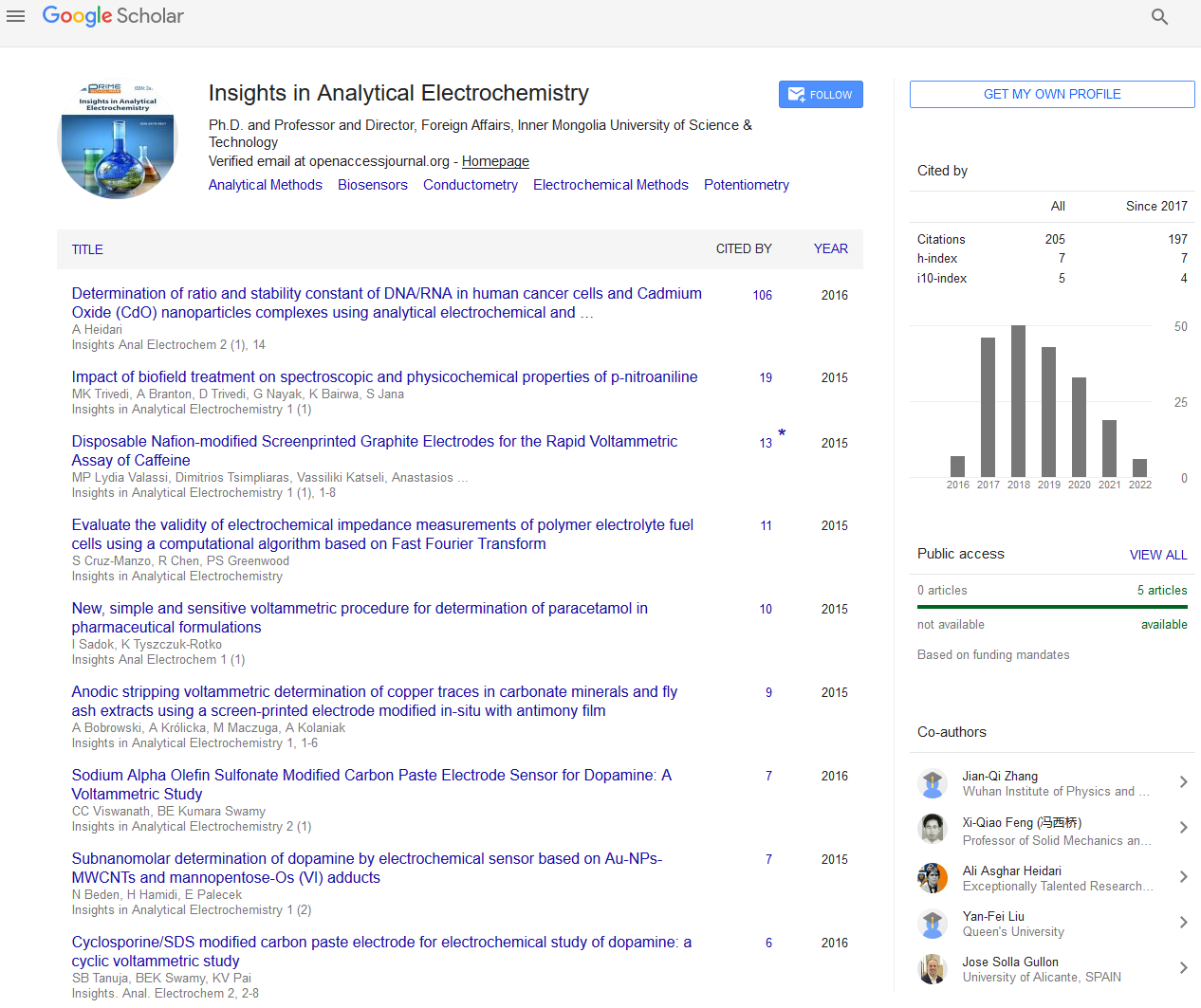Commentary Article - (2023) Volume 9, Issue 4
Amperometry: Illuminating the Currents of Chemical Reactions
Harold Kung*
Department of Chemical Engineering, University Park, Nottingham, UK
*Correspondence:
Harold Kung,
Department of Chemical Engineering, University Park, Nottingham,
UK,
Email:
Received: 29-Nov-2023, Manuscript No. ipaei-24-18859;
Editor assigned: 01-Dec-2023, Pre QC No. ipaei-24-18859 (PQ);
Reviewed: 15-Dec-2023, QC No. ipaei-24-18859;
Revised: 20-Dec-2023, Manuscript No. ipaei-24-18859 (R);
Published:
27-Dec-2023, DOI: 10.21767/2470-9867-9.4.39
Description
In the intricate tapestry of analytical techniques, amperometry
emerges as a beacon of precision, illuminating the currents of
chemical reactions. Rooted in the measurement of current,
amperometry allows us to navigate the dynamic landscape
of electrochemistry with unparalleled accuracy. This method,
akin to a skilled storyteller, unfolds narratives of reactions,
offering insights into the molecular intricacies that shape our
understanding of the chemical world. At its heart, amperometry
delves into the flow of electric current between electrodes
immersed in a solution. This elegant technique captures
the essence of electrochemical reactions, transforming the
invisible dance of electrons into measurable signals. Like a
masterful conductor guiding an orchestra, amperometry
orchestrates the symphony of currents, enabling chemists to
decipher the intricacies of redox processes and beyond. One
of the primary applications of amperometry lies in biosensors.
These miniature marvels employ the method to detect specific
biological molecules by measuring the current generated
in enzymatic reactions. Imagine a biosensor as a vigilant
sentinel, translating biochemical events into electrical signals.
This capability has revolutionized fields such as healthcare
and diagnostics, offering rapid and sensitive detection of
biomarkers, pathogens, and even pollutants. The versatility
of amperometry extends to environmental monitoring,
where it serves as a crucial tool in detecting and quantifying
pollutants. By harnessing the power of current, environmental
scientists can track the presence of contaminants in air, water,
and soil, contributing to our understanding of ecological
health. Amperometry becomes a silent guardian, alerting
us to potential threats to the environment and human wellbeing.
In electroanalytical chemistry, amperometry assumes a
pivotal role in the determination of trace concentrations. The
technique’s sensitivity allows for the detection of substances
at remarkably low levels, making it indispensable in fields such
as pharmaceuticals and food analysis. As a detective probing
the molecular realm, amperometry unveils the identity and
concentration of substances, ensuring the safety and quality of
various products. The marriage of amperometry with modern
technology has birthed innovations like electrochemical cells
and sensors. These devices, imbued with the ability to interpret
currents, have found applications in diverse domains, from
point-of-care diagnostics to industrial process monitoring. The
seamless integration of amperometry into these technologies
heralds a new era of precision and efficiency in analytical
methodologies. Amperometry’s journey into the microscopic
world of cells and tissues has paved the way for advancements in
bioelectrochemistry. By probing the electrochemical processes
within living organisms, scientists gain a deeper understanding
of cellular function and metabolic pathways. Amperometry
becomes a tool of exploration, unraveling the mysteries of
bioelectrochemical phenomena and opening new avenues for
therapeutic interventions. In conclusion, amperometry stands
as a luminary in the realm of analytical chemistry, shedding
light on the currents that shape the chemical landscape. Its
applications span from biosensors revolutionizing healthcare
to environmental monitoring safeguarding our planet. The
precision and sensitivity inherent in amperometry make it a
cornerstone in the arsenal of analytical techniques, guiding
us through the complex narratives of chemical reactions and
offering insights that resonate across scientific disciplines. As
we continue to unravel the secrets encoded in the language
of currents, amperometry remains a steadfast companion,
illuminating the pathways to a deeper understanding of the
molecular world.
Acknowledgement
None.
Conflict Of Interest
The author’s declared that they have no conflict of interest.
Citation: Kung H (2023) Amperometry: Illuminating the Currents of Chemical Reactions. Insights Anal Electrochem. 9:39.
Copyright: © 2023 Kung H. This is an open-access article distributed under the terms of the Creative Commons Attribution License, which permits unrestricted use, distribution, and reproduction in any medium, provided the original author and source are credited.

